Is it possible to make good photographs from the window of a moving train? If you asked me last month I would have said absolutely not. The windows are blotchy with dirt and watermarks. Reflections abound. And what about the speed you are traveling at?
I have since realized I was wrong. I actually got some decent pictures on a moving train.
Amtrak Coast Starlight
A couple of weeks ago I traveled on the Coast Starlight, an Amtrak train that journeys from Los Angeles to Seattle, with many stops in-between. Photography was the last thing on my mind for the reasons I mentioned above. I just packed my little Fuji X100F, a fixed focal length camera, thinking the only images I would be taking on my short vacation would be of friends and family in Seattle and Los Angeles.
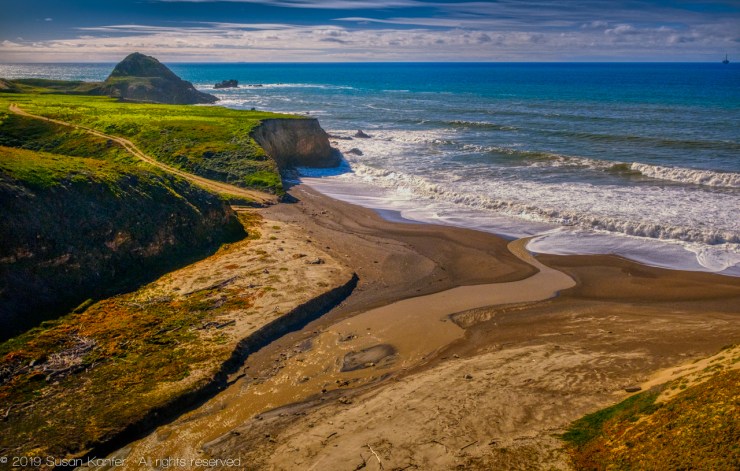
The Coast Starlight traversed incredible scenery, from ocean cliffs and beaches to rugged mountain wilderness. The train ride did not disappoint. I made the trip in winter on purpose, hoping for snow in the mountains. I was blessed. There wasn’t just snow on the ground. There was a giant snowstorm, with flakes swirling through the air. It was absolutely breathtaking. Pristine mountain wilderness blanketed in soft winter white.
Although I doubted good photography was possible, I whipped out my little camera and decided to figure out a way to capture the beauty whizzing by. At least with a digital camera, it is very inexpensive to take lots of bad images amid the “keepers.”
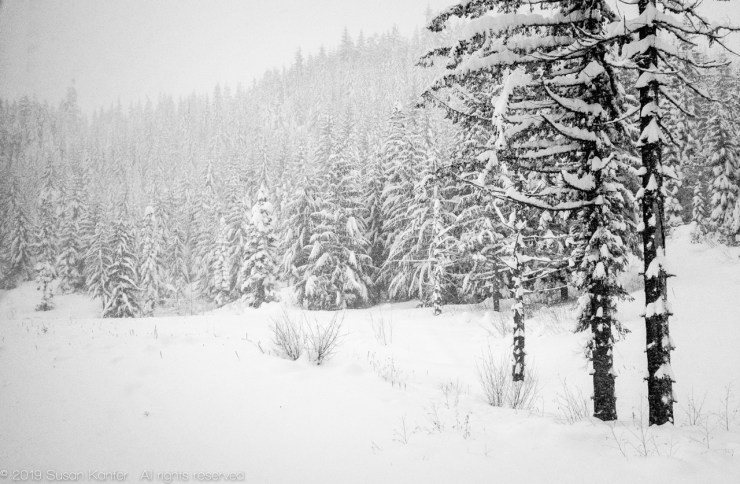
Basic settings
My basic camera settings as the train zipped along were a shutter speed of 1/4000s, an aperture of F 2, and an auto ISO with a maximum ISO of 12,800. A slower shutter speed just didn’t seem to work. I was shooting at very high ISO’s most of the trip. Fuji cameras perform well in low light with high ISOs. It is one of the reasons I love my cameras.
The less-than-ideal shooting conditions opened the door to creative options. Noise and loss of resolution blended into the subject matter. In some images, I reduced noise in processing. Since noise reduction softens images I will often add grain, simulating the look of film. I use software by Imagenomic. Noiseware to reduce noise and Realgrain to add in grain.
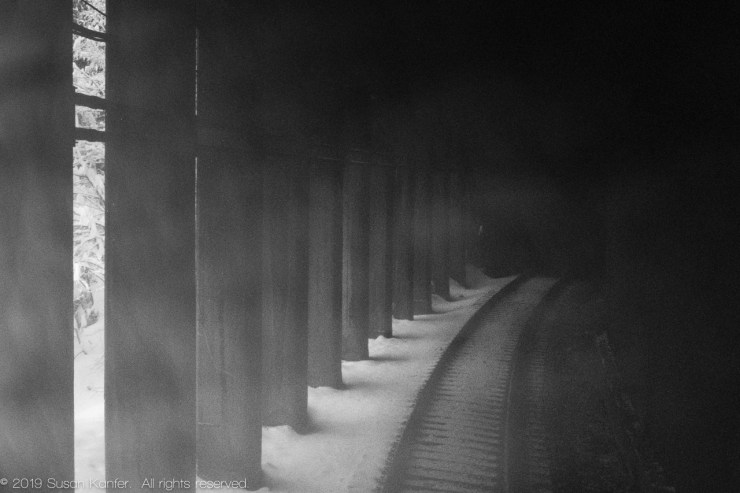
Messy windows
As I had surmised, windows were blotchy and had reflections, I just kept looking until I found a spot on a window that looked pretty clear to shoot through. My plan was to clone out dirty spots and reflections in Photoshop, if necessary. Standing close to the window, I used my body as a tripod with my elbows tight against my chest, keeping the camera as steady as possible.
Different views
There are lots of window choices on a train. My bedroom, on the second level of the train, had a huge picture window. I could stand where ever I wanted and move around with ease. Comfortable as I was, I also checked out the windows on the opposite side of the train and in other cars, for different perspectives. This train had an amazing observation car, with floor to ceiling windows. The views were spectacular, particularly as we moved through the snowstorm.
Photographing from the very last car of a train is also a great idea. It may be possible to catch a picture of the engine as the train curves around the bend. The back window is a view unlike any other, with the tracks stretching back through the frame. On this trip, it happened to be full of water drops due to the snowstorm. I was able to create some interesting effects shooting through the drops.
Sunrise viewed from the observation car after we had just passed Mt. Shasta in northern California, was memorable. At 6:50 a.m. only one other person was in the car with me. Afterward, I walked through to the dining car and enjoyed a pancake breakfast with mountain views on either side. As I drank my coffee I promised myself I would return to the Coast Starlight in the summer, when the days are their longest.
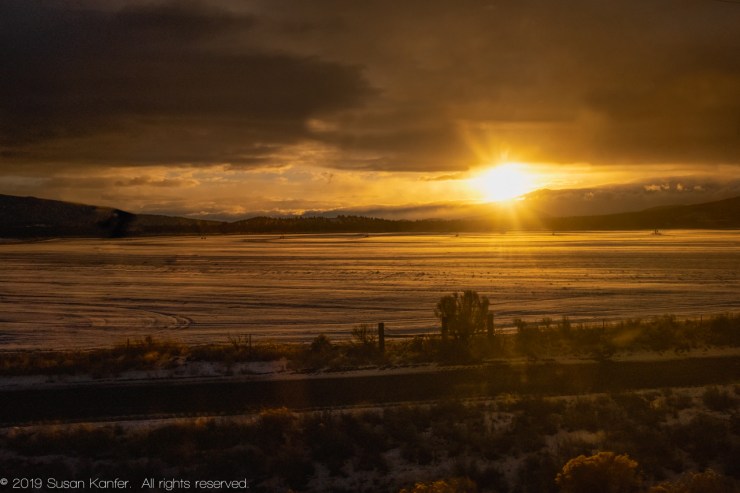
Anticipating the train’s movement
Anticipating a train’s movements is also important. As the train slowed down or came to a complete stop, I was ready to instantly reset my camera to a lower ISO, slower shutter speed, and smaller aperture. I knew this would improve image quality if the window I was shooting from wasn’t too dirty or the reflections too great.
Manual focus
When the train was moving quickly I set my camera on manual focus. I was concerned autofocus might not react fast enough to the fast-changing light and scenery. Even if the background of the image was sharp, at times the foreground was not. My feeling is that a blurred foreground can always be cropped out, if necessary.
In addition to using manual focus as the train zoomed along, I set my camera to continuous shooting mode. I could then fire away, taking many images at once. At least one image in the group would hopefully turn out OK, particularly since miscellaneous telephone or lamp poles seemed to creep into my photos unexpectedly.

More than a train ride
Train travel north to Seattle isn’t just about a beautiful ride. It is a total experience. Meeting and talking with diverse people. Sharing stories while eating a meal with new friends. It is about slowing down and having time to read a book, watch a movie on an iPad, or do nothing.
Next time I travel the Coast Starlight, hopefully in the summer, I will pack my Fuji X-T3 with a few lenses, giving me a greater range of focal lengths. I will add depth to my storytelling, taking photographs of people, stations, the train interior, and food, as well as scenery. I will again travel south to north, preferring the daylight views.
Traveling the train can definitely be a photographic journey, and easily shared with friends and family. Amtrak has routes throughout the country, for short and long distances. You might consider a train ride in your future vacation plans.
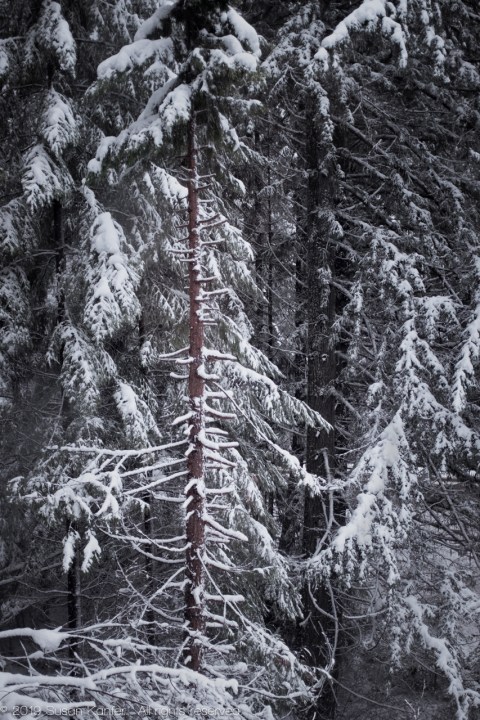
Tell your story with the second annual Visual Storytelling Conference!
Experience four days of interactive, online training sessions featuring a range of educational content with experienced photographers and content creators. This free event kicks off with a series of technical boot camps to build essential skills, followed by live, online sessions on photography, video, business and social media. Join live from March 10-13, 2022!
